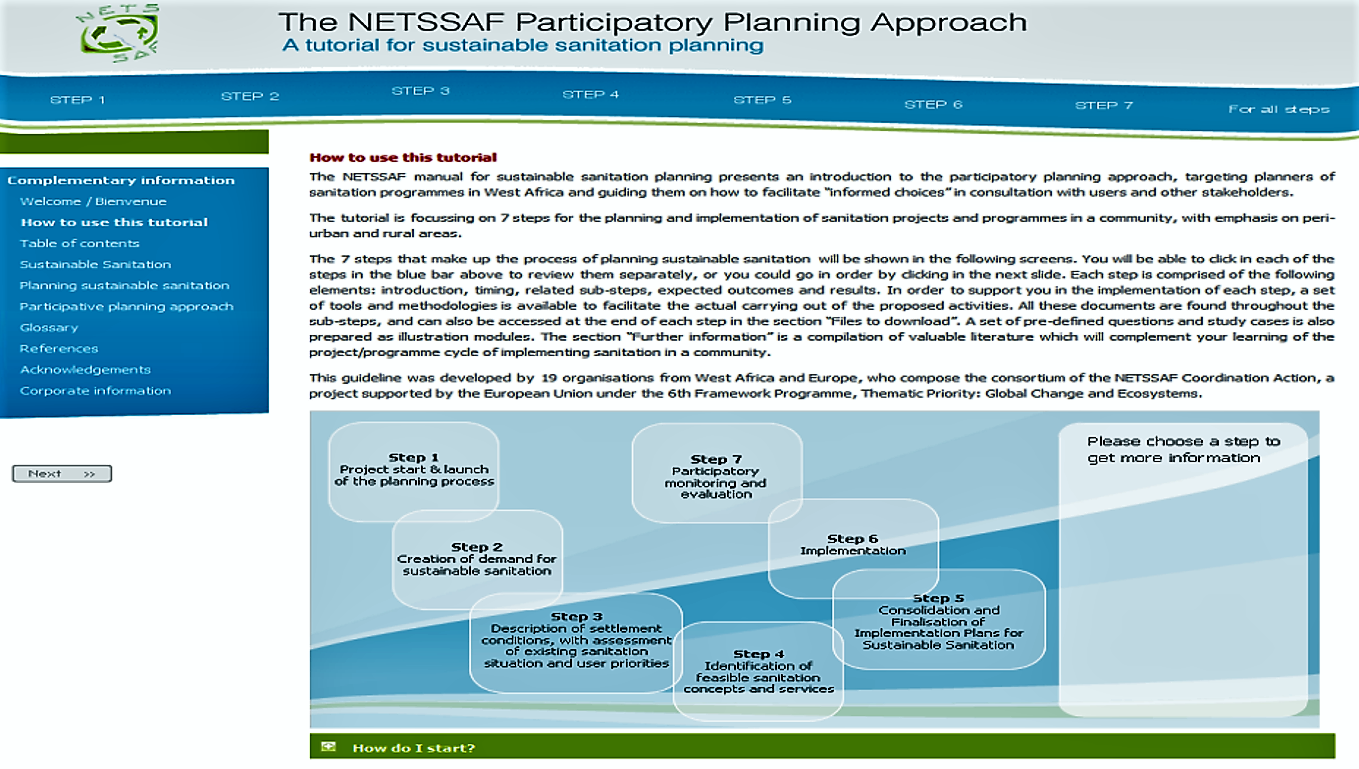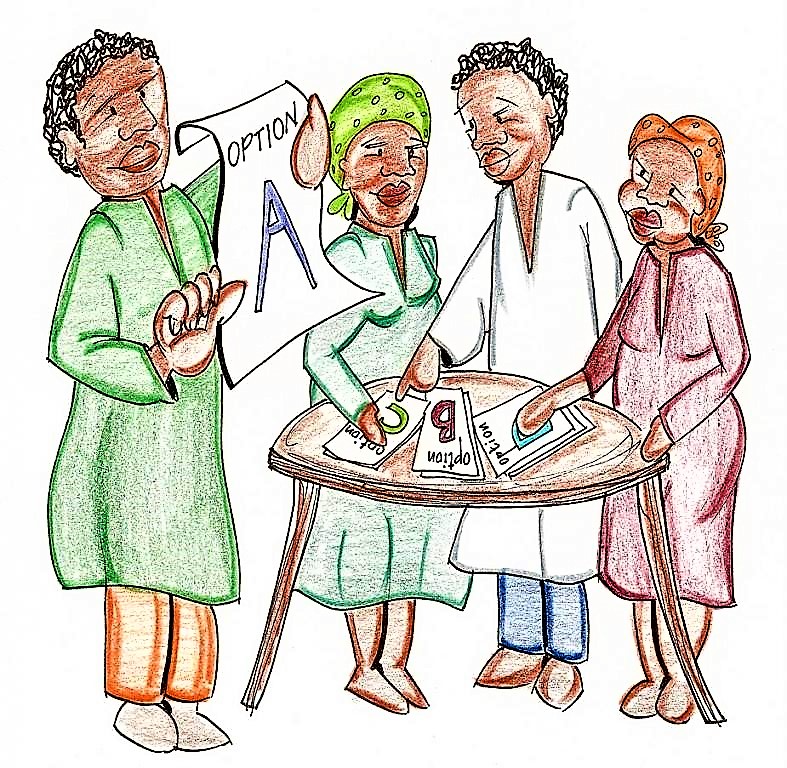Executive Summary
The tutorial for sustainable sanitation planning is a ready source of information for decision makers and individuals involved in setting up municipal wastewater systems and concepts for management of excreta in communities in (developed for West Africa). The guide, offered as CD-Rom, as a link on the internet and in a printed version, illustrates a participatory approach to sanitation planning, dealing with the complex stakeholders concerns when deciding and implementing a sanitation system. It takes the user through a seven-step-approach, each of them with pre-selected questions and answers, case studies, links for further information and tools to facilitate the adoption of participatory sanitation planning in localities in West Africa (BARRETO et al. 2008).
Basic Understanding

The NETSSAF tutorial for sustainable sanitation planning presents an introduction to the participatory planning approach, targeting planners of sanitation programmes in West Africa and elsewhere and guiding them on how to facilitate “informed choices” in consultation with users and other stakeholders (read more on stakeholder identification factsheet) (BARRETO et al. 2008). The tutorial is focussing on seven steps for the planning and implementation of sanitation projects and programmes in a community, with emphasis on peri-urban and rural areas, which include (BARRETO and ONADIPE 2008) the following (Note: you will find tools for each of these steps also in the links shown at the end of every paragraph).
- STEP 1 (Project start-up and launch of the planning process): In this phase, the general problem and the overall goals of the project are formulated. A consensus regarding the project goals and boundary conditions should be reached through a series of discussions with key stakeholders and drafted into official document (find other tools to explore here).
- STEP 2 (Creation of demand for improved sanitation): Sanitation requires intervention at both household and community levels. Therefore, raising the demand for such services from individuals becomes of paramount importance for the project success. Awareness raising activities must reach out to all members of the community, including diverse gender, ethnic and class groups, and be structured so as to provide a relevant message to each group. This is an on-going activity and will continue throughout the subsequent planning steps and beyond (see also demand creation).
- STEP 3 (Description of settlement conditions, with assessment of existing sanitation situation and user priorities): This step will collect the background information necessary to determine the terms of requirement for a sanitation system from both technical and user perspectives (see also: baseline data collection).
- STEP 4 (Identification of feasible sanitation concepts and service systems): The objective of this step is to reach a decision about the most suitable sanitation system based on the baseline information gathered in step 3, an assessment of the enabling environment, information on user priorities, and any additional knowledge that was gained from exposure sub-step (see also the various tools on the decision making site).
- STEP 5 (Consolidation and finalisation of implementation plans for sustainable sanitation): In this step, an action plan for the implementation of the sanitation structures will be developed, as well as the corresponding management system. Financing methods, roles and responsibilities in construction, operation, and maintenance of the chosen system are clarified (see e.g. stakeholder strategy plan).
- STEP 6 (Implementation): Implementation is a multi-step process itself, and requires an adaptive and flexible project management approach with continuous feed-back via monitoring and evaluation systems. This step is designed to govern the process and key conditions necessary for successful implementation and service delivery (see also project implementation).
- STEP 7 (Participatory monitoring and evaluation): Participatory monitoring and evaluation (PM&E) methods are used throughout the project as a feedback system to increase the consensus on appropriateness of goals, objectives and activities. It provides timely, reliable, and valid information for coordinating the other planning and decision making steps (see also monitoring and evaluation).

The tutorial, available in French and English, has been designed as a web-based tool (see the NETSSAF manual for more information). The 7 steps that make up the process of planning sustainable sanitation are shown in different screens. Each step is comprised of the following elements: introduction, timing, sub-steps, expected outcomes and results. In order to support the implementation of each step, a set of tools and methodologies is available to facilitate the actual carrying out of the proposed activities. A set of pre-defined questions and study cases is also prepared as illustration modules. The section “Further information” is a compilation of literature which will complement users’ understanding of the project/programme cycle of implementing sanitation in a community. To be used as reference, the tutorial also contains a section called “For all steps” in which the following components can be observed: validation of key actors and their roles, technical and non-technical requirements, differentiating between peri-urban and rural. Finally, the system also includes a full menu with complementary information related to sustainable sanitation, planning sustainable sanitation and participatory planning approach. This guideline was developed by 19 organisations from West Africa and Europe, which make up the NETSSAF consortium, a project supported by the European Union under the 6th Framework Programme.
Subscribe here to the new Sanitation and Water Entrepreneurship Pact (SWEP) newsletter. SWEP is a network of organizations joining hands to help entrepreneurs design and develop lasting water and sanitation businesses.
The NETSSAF tutorial for sustainable sanitation planning was designed to support planners and engineers in West Africa to carry out a participative process when planning sanitation in rural and peri-urban areas in a local level. However, the steps and the different tools and methodologies are in most of the cases general enough to be used in urban areas and not exclusively under the West African conditions. The idea was to offer a source of information and not to present a blue print process to be repeated in all the cases.

With this, the user should take the approaches and tools he/she would find applicable and adapt them to the respective local conditions. Although the tutorial was prepared to support sanitation planning processes, the participative approaches and techniques for the involvement of the beneficiaries could be also be interesting in any other water project.
Development of Sustainable Approaches for Large Scale Implementation of Sanitation in West Africa. Proceedings at IWA Conference
Introduction to the NETSSAF Participatory Planning Approach, a tutorial and guideline for sustainable sanitation planning
This presentation describes the NETSSAF participatory planning approach in a brief manner.
BARRETO DILLON, L. BUZIE FRU, C. (2008): Introduction to the NETSSAF Participatory Planning Approach, a tutorial and guideline for sustainable sanitation planning . (= Proceedings of the NETSSAF Final Conference “Pathways towards Sustainable Sanitation in Africa" ). Ouagadougou (Burkina Faso): Network for the development of Sustainable Approaches for large scale implementation of Sanitation in Africa (NETSSAF) URL [Accessed: 18.07.2019] PDFNETSSAF Participatory Planning-Approach
This is the actual tutorial of the participative planning approach developed by NETSSAF, containing all the steps, sub-steps and case studies. It is freely available on the internet in French and English.
NETSSAF (2008): NETSSAF Participatory Planning-Approach. A tutorial for sustainable sanitation planning. Network for the Development of Sustainable Approaches for Large Scale Implementation of Sanitation in Africa (NETSSAF). [Accessed: 29.03.2010] PDFThe NETSAFF Participatory Planning Approach
This guideline is a ready source of information for decision makers and individuals involved in setting up municipal wastewater systems and concepts for management of excreta in communities in West Africa. The guide illustrates a participatory approach to sanitation planning, dealing with the complex stakeholder concerns when deciding and implementing a sanitation system. This tutorial will take you through a seven-step approach for participatory planning (PP) of sanitation. To aid your understanding of the process, each step is provided with preselected questions and answers, case studies, links for further information and tools to facilitate the adoption of participatory sanitation planning in local regions. We invite you to discover this tutorial, and continue working in the field of sanitation to improve the wellbeing of the members in your community!
NETSSAF (2008): The NETSAFF Participatory Planning Approach. A Tutorial for Sustainable Sanitation Planning. [Accessed: 27.03.2012]Introduction to the NETSSAF Participatory Planning Approach, a tutorial and guideline for sustainable sanitation planning (brief)
This document presents the NETSSAF participatory planning approach in a brief manner.
BARRETO DILLON, L. BUZIE FRU, C. ROBERTI PÉREZ, L. (2008): Introduction to the NETSSAF Participatory Planning Approach, a tutorial and guideline for sustainable sanitation planning (brief). (= Proceedings of the NETSSAF Final Conference “Pathways towards Sustainable Sanitation in Africa" ). Ouagadougou (Burkina Faso): Network for the development of Sustainable Approaches for large scale implementation of Sanitation in Africa (NETSSAF). [Accessed: 02.04.2010] PDFNETSSAF Participatory Planning-Approach
This is the actual tutorial of the participative planning approach developed by NETSSAF, containing all the steps, sub-steps and case studies. It is freely available on the internet in French and English.
NETSSAF (2008): NETSSAF Participatory Planning-Approach. A tutorial for sustainable sanitation planning. Network for the Development of Sustainable Approaches for Large Scale Implementation of Sanitation in Africa (NETSSAF). [Accessed: 29.03.2010] PDFNETSSAF Participatory Planning Approach. A Tutorial for Sustainable Sanitation
This document presents an overview of some existing participatory sanitation planning tools, illustrating the scope of the steps and some of the common methodologies employed in the various frameworks.
NETSSAF (2008): NETSSAF Participatory Planning Approach. A Tutorial for Sustainable Sanitation. Network for the development of Sustainable Approaches for large scale implementation of Sanitation in Africa (NETSSAF). [Accessed: 10.02.2010] PDFIntroduction to the NETSSAF Participatory Planning Approach, a tutorial and guideline for sustainable sanitation planning
This presentation describes the NETSSAF participatory planning approach in a brief manner.
BARRETO DILLON, L. BUZIE FRU, C. (2008): Introduction to the NETSSAF Participatory Planning Approach, a tutorial and guideline for sustainable sanitation planning . (= Proceedings of the NETSSAF Final Conference “Pathways towards Sustainable Sanitation in Africa" ). Ouagadougou (Burkina Faso): Network for the development of Sustainable Approaches for large scale implementation of Sanitation in Africa (NETSSAF) URL [Accessed: 18.07.2019] PDF

